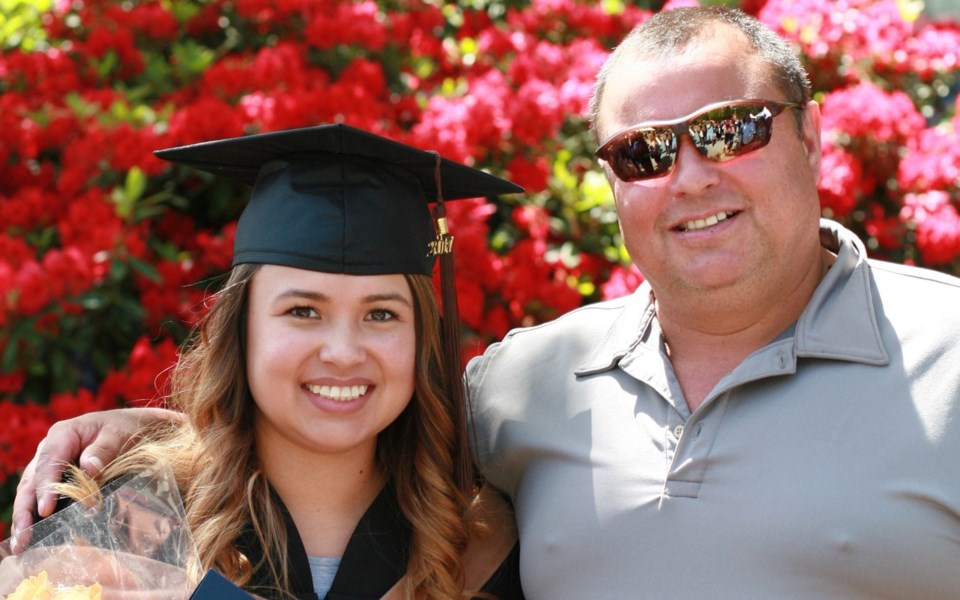Kamana Bikadi has a lot on her plate. The recent university graduate has a full-time gig at Deloitte, one of the world's largest accounting firms.
But she's about to take on even more: two years of study that will see her gain her Chartered Professional Accountant designate.
Bikadi, who grew up in Mount Currie, is part of a growing cohort of Lil'wat First Nations members who are finding success in higher education.
Within the last 10 years, the First Nation has doubled the number of students enrolled in post-secondary institutions, from 22 in 2010 to 46 this year.
"More people have been showing interest in going to school," explained Bikadi. "A few members of this generation decided to go, and then others, who are younger, saw that."
Lois Joseph, a longtime Lil'wat band councillor who handles the nation's higher education portfolio, draws a connection between efforts to revitalize Lil'wat culture and the mounting success.
She noticed a big difference when young people "are embedded in their culture and history," explained Joseph, who began running a traditional dancing group in the 1990s.
Over the years, it's grown dramatically. "If we know who we are, it makes us proud of who we are and stronger in what we do," she explained.
Another contributing factor has been the Ts'zil Learning Centre, an adult education centre that offers a wide range of programs, including academic upgrading, trades training, and select university-level courses.
Ts'zil is located in Mount Currie and Bikadi said it played a key role in her success. A couple years after graduating high school, she showed up, looking for advice.
"I went there having no idea what I was going to do."
Someone recommended business, and after completing academic upgrading at Ts'zil, Bikadi transferred to Capilano University, where she completed a bachelor of business administration.
For Lisa Fisher, an educator and administrator at Ts'zil, Bikadi is an outstanding example as of an encouraging trend of students.
Of the 46 members enrolled in post-secondary schools, 27 are getting their bachelors degrees, two their masters, and the others are in various certificate and diploma programs, she said.
Students are studying a wide range of subjects, including nursing, computer science, fine arts and education.
"There's a big need in community for First Nations teachers. So that's been a priority," she said.
Fisher — who likes to refer to Ts'zil as a "bridge" — said the school helps students gain the confidence, grades and pre-requisites to transition into post-secondary studies.
"I think a lot of young people feel that if you don't go to (college) right after high school, (you're) a failure," she said, explaining that Ts'zil serves as a way to help them.
Ts'zil, moreover, is about to get a whole lot nicer.
For years, it's operated out of portables. But a new building is under construction. The building will feature an ishkin, an underground living structure used to survive winter months.
"When the building honours and respects the traditions of the people on the territory that says something," said Fisher, who hopes to bring more educational options to the school.
Over at Xitólacw Community School, a pre-K to Grade 12 school that's run by the Lil'wat First Nation, school principal Rosa Andrew said the aim is to strike a balance between a solid Western education and immersing students in Indigenous culture.
"Students are allowed to get an education without losing their identity," she explained, drawing a sharp contrast between Xitólacw and residential schools, which sought to rob students of their cultural identity.
A big component of students' education is getting them out on the land, said Andrew.
Grade 8 to 12 students are able to take "super courses." The multi-day trips expose students to cultural sites and are taught with the assistance of elders, who share traditional teachings.
"We teach a lot about culture, language, and customs," explained Andrew. "My vision is for students to have pride in who they are."
That same ethos is behind efforts to introduce Indigenous knowledge and language into Pemberton public schools, which are administered by School District 48 (SD 48) and draw students from Mount Currie.
SD 48 has won praise for its efforts to improve educational outcomes for Indigenous students.
The district boasts a high school graduation rate of 82 per cent for its Indigenous students — the provincial completion rate for Indigenous is 64 per cent.
In recent years, SD 48 has signed a number of partnership agreements with Sea to Sky First Nations, which has led to the teaching of Indigenous culture and language.
"We're going from having culture shared on the side every now and then, to elders going in and teaching our teachers how to incorporate local culture right in their classrooms every day," explained district superintendent Lisa McCullough.
"We have very specific culture and language programming that didn't exist before." SD 48 is also following B.C.'s new mandatory First Peoples curriculum, which aims to bring Indigenous forms of knowledge and understanding into every class, whether it be math or social studies.
The curriculum is based on Indigenous principles of learning, which emphasize that "learning ultimately supports the well-being of the self, the family, the community, the land, the spirit, and the ancestors," according to a document that outlines the approach.
SD 48 also has Aboriginal support workers who work directly with Indigenous students. The district does not keep track of how many go on to higher education, however.
According to Susan Leslie, SD 48's principal of Aboriginal education, working with communities to establish educational objectives and making sure every student is looked after in a holistic way has paid big dividends.
"When you have an all-encompassing learning plan for every student in your district — that is done through an Aboriginal lens — then you start fulsome learning opportunities in every classroom," she explained.




